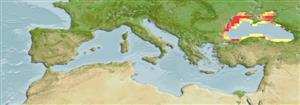Common names from other countries
分类 / Names
俗名 | 同种异名 | Catalog of Fishes(属, 种) | ITIS | CoL | WoRMS | Cloffa
Teleostei >
Clupeiformes (Herrings) >
Alosidae (Shads and Sardines)
Etymology: Alosa: Latin, alausa = a fish cited by Ausonius and Latin, halec = pickle, dealing with the Greek word hals = salt; it is also the old Saxon name for shad = "alli" ; 1591 (Ref. 45335).
More on author: Bennett.
Environment: milieu / climate zone / depth range / distribution range
生态学
海洋; 淡水; 半咸淡水; 溯河洄游 (Ref. 51243); 深度上下限 3 - 90 m (Ref. 10439). 溫帶; 50°N - 41°N, 27°E - 44°E
Eurasia: Black Sea and Sea of Azov ( in sea and in the Don, Danube and other rivers, as much as 567 km up the Don and as far as Kiev on the Dneiper before the dam was built). Recognized sub-species (Ref. 683): Alosa pontica pontica in the Black Sea and rivers feeding it; Alosa pontica kessleri and Alosa pontica volgensis in the Caspian Sea.
歐亞大陸: 黑海與亞速海.( 在海洋與頓河, 多瑙河與其他的河中, 高達 567個公里上游頓河與遠達在內波河上的基輔在水壩建好以前) 公認的亞種:(參考文獻 683) 在黑海與河的 Alosa pontica pontica 進食它; 在裡海的 Alosa pontica kessleri 與 Alosa pontica volgensis。 伯恩公約的附錄 3(受保育的動物群).
大小 / 重量 / 年龄
Maturity: Lm ? range ? - 23.4 cm
Max length : 39.0 cm SL 雄鱼/尚未辨别雌雄; (Ref. 188); 最大年龄: 7 年 (Ref. 10439)
背棘 (总数) : 0; 臀棘: 0. Body fairly elongate, more `herring-like' than `shad-like'. Gill rakers rather thin, usually equal to or a little shorter than gill filaments. Teeth well developed in both jaws. Resembles A. caspia, which usually has more Gill rakers (50 to 180, much longer than gill filaments), poorly developed teeth and a deeper, `shad-like' body; A. maeotica has fewer Gill rakers (33 to 36).
身体相当延长, 更多的像鲱鱼一样的 '超过像非鱼类一样的'. 鳃耙相当细, 通常等于或稍微短于鳃丝。 双颚内的齿发展良好的。 与 A. caspia 相似, 通常有更多的鳃耙 (50 到 180, 远长过鳃丝) ,发展不良的齿与比较深,像非鱼类一样的' 身体; A. maeotica 有较少的鳃耙。 (33 到 36)
Thai species is pelagic at sea, in deep water. It migrates to middle reaches of large rivers, spawning where current is strongest, close to the surface, often at 2-3 m depth in the main channel. Migrates upriver to spawn at 3 years, rarely earlier and only a few individuals spawn two seasons. It appears along the coast in March to April, enters rivers when temperatures reach about 6-9°C, between late March and late April; migration usually peaks in May. Spawning starts when temperature rises above 15°C in April to August; usually between 1 and 8 p.m. Pelagic eggs. Spent individuals return to the sea to feed. Juveniles inhabit floodplain and shallow riverine habitats, migrate to the sea or estuarine habitats during first summer; in autumn return to the sea until maturity. When at sea, it feeds on a wide variety of zooplankton (mainly crustaceans, (Crangon, Upogebia, Idothea, gammarids) and small fish (Engraulis, Clupeonella, Sprattus). Reduction of spawning sites and migration routes are caused by impoundment of main rivers. Heavy over fishing apparently reduced all populations during the first decade of the 20th century (Ref. 59043). Reaches a smaller size (30 cm SL, usually 14-18) in Don River; a smaller form reaches only 21 cm.
在春天与初夏在黑海向北回游。 主要吃小鱼 ( Engraulis , Clupeonella, Sprattus) ,也吃甲壳动物。 ( Crangon , Upogebia , Idothea, 夜蛾) 在河中产卵从五月中旬到八月中旬在下游中到高达 500 公里或更多向上游。 幼鱼下降得很快但是逗留在或在三角州或河口的附近直到冬天。 体型小 (30 公分 SL, 通常 14-18) 在顿河河; 一个较小的形式只达到 21 公分。
Eggs are pelagic (Ref. 59043).歐亞大陸: 黑海與亞速海.( 在海洋與頓河, 多瑙河與其他的河中, 高達 567個公里上游頓河與遠達在內波河上的基輔在水壩建好以前) 公認的亞種:(參考文獻 683) 在黑海與河的 Alosa pontica pontica 進食它; 在裡海的 Alosa pontica kessleri 與 Alosa pontica volgensis。 伯恩公約的附錄 3(受保育的動物群).
Kottelat, M., 1997. European freshwater fishes. An heuristic checklist of the freshwater fishes of Europe (exclusive of former USSR), with an introduction for non-systematists and comments on nomenclature and conservation. Biologia, Bratislava, 52/Suppl. 5:1-271. (Ref. 13696)
CITES (Ref. 128078)
Not Evaluated
人类利用
渔业: 低经济
工具
特别资料
下载 XML
网络资源
Estimates based on models
Preferred temperature (Ref.
115969): 8.6 - 14.8, mean 13.3 (based on 68 cells).
Phylogenetic diversity index (Ref.
82804): PD
50 = 0.5000 [Uniqueness, from 0.5 = low to 2.0 = high].
Bayesian length-weight: a=0.01318 (0.00777 - 0.02235), b=2.99 (2.84 - 3.14), in cm Total Length, based on LWR estimates for this species & Genus-body shape (Ref.
93245).
营养阶层 (Ref.
69278): 4.0 ±0.6 se; based on diet studies.
回复力 (Ref.
120179): 中等的, 族群倍增时间最少 1.4 - 4.4年 (K=0.32; tm=2; tmax=9).
Fishing Vulnerability (Ref.
59153): Low to moderate vulnerability (35 of 100).
Climate Vulnerability (Ref.
125649): High to very high vulnerability (67 of 100).
